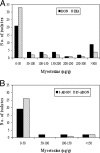Comparative mycotoxin profiles of Gibberella zeae populations from barley, wheat, potatoes, and sugar beets
- PMID: 18791024
- PMCID: PMC2576685
- DOI: 10.1128/AEM.01580-08
Comparative mycotoxin profiles of Gibberella zeae populations from barley, wheat, potatoes, and sugar beets
Abstract
Gibberella zeae is one of the most devastating pathogens of barley and wheat in the United States. The fungus also infects noncereal crops, such as potatoes and sugar beets, and the genetic relationships among barley, wheat, potato, and sugar beet isolates indicate high levels of similarity. However, little is known about the toxigenic potential of G. zeae isolates from potatoes and sugar beets. A total of 336 isolates of G. zeae from barley, wheat, potatoes, and sugar beets were collected and analyzed by TRI (trichothecene biosynthesis gene)-based PCR assays. To verify the TRI-based PCR detection of genetic markers by chemical analysis, 45 representative isolates were grown in rice cultures for 28 days and 15 trichothecenes and 2 zearalenone (ZEA) analogs were quantified using gas chromatography-mass spectrometry. TRI-based PCR assays revealed that all isolates had the deoxynivalenol (DON) marker. The frequencies of isolates with the 15-acetyl-deoxynivalenol (15-ADON) marker were higher than those of isolates with the 3-acetyl-deoxynivalenol (3-ADON) marker among isolates from all four crops. Fusarium head blight (FHB)-resistant wheat cultivars had little or no influence on the diversity of isolates associated with the 3-ADON and 15-ADON markers. However, the frequency of isolates with the 3-ADON marker among isolates from the Langdon, ND, sampling site was higher than those among isolates from the Carrington and Minot, ND, sites. In chemical analyses, DON, 3-ADON, 15-ADON, b-ZEA, and ZEA were detected. All isolates produced DON (1 to 782 microg/g) and ZEA (1 to 623 microg/g). These findings may be useful for monitoring mycotoxin contamination and for formulating FHB management strategies for these crops.
Figures



Similar articles
-
Genetic relationships among populations of Gibberella zeae from barley, wheat, potato, and sugar beet in the upper Midwest of the United States.Phytopathology. 2008 Sep;98(9):969-76. doi: 10.1094/PHYTO-98-9-0969. Phytopathology. 2008. PMID: 18943734
-
Trichothecene profiling and population genetic analysis of Gibberella zeae from barley in North Dakota and Minnesota.Phytopathology. 2011 Jun;101(6):687-95. doi: 10.1094/PHYTO-04-10-0101. Phytopathology. 2011. PMID: 21244225
-
Trichothecene genotypes and production profiles of Fusarium graminearum isolates obtained from barley cultivated in Argentina.Int J Food Microbiol. 2014 Jun 2;179:57-63. doi: 10.1016/j.ijfoodmicro.2014.03.024. Epub 2014 Mar 28. Int J Food Microbiol. 2014. PMID: 24727383
-
Strategies for managing Fusarium head blight and deoxynivalenol accumulation in wheat.Int J Food Microbiol. 2007 Oct 20;119(1-2):126-30. doi: 10.1016/j.ijfoodmicro.2007.07.033. Epub 2007 Jul 31. Int J Food Microbiol. 2007. PMID: 17716767 Review.
-
Biological control of Fusarium head blight of wheat and deoxynivalenol levels in grain via use of microbial antagonists.Adv Exp Med Biol. 2002;504:53-69. doi: 10.1007/978-1-4615-0629-4_6. Adv Exp Med Biol. 2002. PMID: 11922099 Review.
Cited by
-
Mycotoxigenic Potentials of Fusarium Species in Various Culture Matrices Revealed by Mycotoxin Profiling.Toxins (Basel). 2016 Dec 26;9(1):6. doi: 10.3390/toxins9010006. Toxins (Basel). 2016. PMID: 28035973 Free PMC article.
-
Nivalenol Mycotoxin Concerns in Foods: An Overview on Occurrence, Impact on Human and Animal Health and Its Detection and Management Strategies.Toxins (Basel). 2022 Jul 31;14(8):527. doi: 10.3390/toxins14080527. Toxins (Basel). 2022. PMID: 36006189 Free PMC article. Review.
-
Survey of mycotoxins in corn distillers' dried grains with solubles from seventy-eight ethanol plants in twelve States in the U.S. In 2011.Toxins (Basel). 2014 Mar 26;6(4):1155-68. doi: 10.3390/toxins6041155. Toxins (Basel). 2014. PMID: 24674933 Free PMC article.
-
E-Screen evaluation of sugar beet feedstuffs in a case of reduced embryo transfer efficiencies in cattle: the role of phytoestrogens and zearalenone.In Vitro Cell Dev Biol Anim. 2012 Apr;48(4):216-28. doi: 10.1007/s11626-012-9489-9. Epub 2012 Feb 21. In Vitro Cell Dev Biol Anim. 2012. PMID: 22350809
-
Identification of Pathogenic Fusarium spp. Causing Maize Ear Rot and Potential Mycotoxin Production in China.Toxins (Basel). 2016 Jun 21;8(6):186. doi: 10.3390/toxins8060186. Toxins (Basel). 2016. PMID: 27338476 Free PMC article.
References
-
- Ali, S., V. V. Rivera, and G. A. Secor. 2005. First report of Fusarium graminearum causing dry rot of potato in North Dakota. Plant Dis. 89:105. - PubMed
-
- Blaney, B. J., and R. L. Dodman. 2002. Production of zearalenone, deoxynivalenol, nivalenol, and acetylated derivatives by Australian isolates of Fusarium graminearum and F. pseudograminearum in relation to source and culturing conditions. Aust. J. Agric. Res. 53:1317-1326.
-
- Brown, D. W., S. P. McCormick, N. J. Alexander, R. H. Proctor, and A. E. Desjardins. 2001. A genetic and biochemical approach to study trichothecene diversity in Fusarium sporotrichoides and Fusarium graminearum. Fungal Genet. Biol. 32:121-133. - PubMed
-
- Burlakoti, R. R., S. Ali, G. A. Secor, S. M. Neate, M. P. McMullen, and T. B. Adhikari. 2008. Genetic relationships among populations of Gibberella zeae from barley, wheat, potato and sugar beet in the upper Midwest of the United States. Phytopathology 98:969-976. - PubMed
Publication types
MeSH terms
Substances
LinkOut - more resources
Full Text Sources

